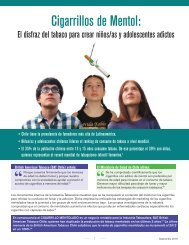Public health successes and missed opportunities
Public-health-successes-and-missed-opportunities-alcohol-mortality-19902014
Public-health-successes-and-missed-opportunities-alcohol-mortality-19902014
You also want an ePaper? Increase the reach of your titles
YUMPU automatically turns print PDFs into web optimized ePapers that Google loves.
<strong>Public</strong> <strong>health</strong> <strong>successes</strong> <strong>and</strong> <strong>missed</strong> <strong>opportunities</strong><br />
• For injury, the relative risks from the meta-analysis of Corrao <strong>and</strong> colleagues (128) were used, modified to incorporate<br />
the effects of binge drinking. While it did not explicitly include risk to others 13 in general, some of the effects of<br />
alcohol use on traffic injury were included. Thus, the WHO Global status report on road safety 2015 was used (133)<br />
as a source for the distribution of the sex of the driver, <strong>and</strong> the number of passengers per car to add to the alcoholattributable<br />
injury. (For general considerations on harm to others, see (14,121).)<br />
• Exposure <strong>and</strong> dose–response relationships were combined using st<strong>and</strong>ard formulas for attributable risk (126)<br />
(for foundation, see (134–136)) to derive alcohol-attributable fractions by sex <strong>and</strong> age (the usual age groups for<br />
comparative risk assessments characterizing alcohol exposure (15–34 years; 35–64 years; <strong>and</strong> 65+ years).<br />
• The alcohol-attributable fractions were then applied to the cause-of-death statistics (137) divided by the respective<br />
population to derive rates per million population. To achieve comparability, the rates were age-st<strong>and</strong>ardized using the<br />
st<strong>and</strong>ard population of the International Agency for Research on Cancer (138).<br />
Burden of Alcohol-attributable mortality in 2014 in the WHO<br />
European Region<br />
Table 1 gives an overview of st<strong>and</strong>ardized mortality rates of major alcohol-attributable disease categories for the year<br />
2014. While the countries with the highest overall rates of alcohol-attributable mortality from the eastern part of the<br />
WHO European Region tend to be the highest in many of the six subcategories of causes of death reported here (i.e. liver<br />
cirrhosis, cancer, CVD, injury, unintentional injury, intentional injury), the results are differentiated by country <strong>and</strong> regionspecific<br />
characteristics.<br />
• Like any other type of alcohol-attributable mortality, mortality rates due to alcohol-attributable liver cirrhosis are<br />
mainly impacted by two factors: the overall mortality rate from liver cirrhosis in the country/region under consideration<br />
<strong>and</strong> the level of alcohol consumption. For European countries with high rates of alcohol-attributable liver cirrhosis,<br />
these two causal factors determine three clusters of countries: 14 first, the central Asian countries of Kazakhstan,<br />
Kyrgyzstan, Turkmenistan <strong>and</strong> Uzbekistan have a high overall prevalence of <strong>and</strong> mortality from liver cirrhosis, in large<br />
part driven by hepatitis B <strong>and</strong> C infections (84). The role of alcohol use may be overestimated by the st<strong>and</strong>ard formulas<br />
for these countries (see above). On the other h<strong>and</strong>, alcohol plays a crucial role in liver cirrhosis mortality, independent<br />
of the original cause for incidence of this disease category, as even relatively small amounts of alcohol may lead<br />
to mortality in people who have the disease, irrespective of its etiological pathway (87). (For the difference in risk<br />
curves between morbidity <strong>and</strong> mortality, see (90,139). 15 ) Second, countries such as Hungary, the Republic of Moldova,<br />
Romania <strong>and</strong> Slovakia have higher liver cirrhosis rates than expected by volume of alcohol consumption alone. There<br />
is some speculation that specific kinds of fruit spirits, where pits (stones) were not separated in the production<br />
process, may play a role here (141). Finally, countries such as Lithuania or Ukraine would be typical of countries with<br />
a high liver cirrhosis rate more or less in line with their high level of overall consumption. It should be noted that<br />
overall tissue exposure seems to be the causal determinant (142,143), <strong>and</strong> that more variable drinking of the same<br />
amount of alcohol does not imply additional risks for liver cirrhosis mortality, as abstinence days are favourable for<br />
liver regeneration (so-called liver holidays (144,145)).<br />
• Of all causes, alcohol-attributable cancer shows by far the least variation between countries <strong>and</strong> by time. Part of the<br />
phenomenon may be due to the long <strong>and</strong> varying lag-time between exposure <strong>and</strong> onset of disease (146). Another<br />
reason is that alcohol is not causally or is only weakly related to the most numerous cancers. As a result, the level<br />
of alcohol consumption is the main determinant of alcohol-attributable cancer mortality, which accounts for less<br />
than 10% of all the cancer mortality in any region of the world. However, the variation in Europe – between 1%<br />
(Turkey) <strong>and</strong> 9% (the Republic of Moldova) – in 2014 for alcohol-attributable fractions of cancer mortality in the WHO<br />
European Region is still very important, 16 given the overall impact of cancer on mortality in the Region.<br />
13<br />
Thus, neither the effects of pregnant women’s drinking on the newborn (such as on FAS or fetal alcohol spectrum disorders, (129,130) or the sequelae of low birth<br />
weight (131)) or the effect of alcohol on aggression towards others was included (132).<br />
14<br />
Only countries with the 10 highest age-st<strong>and</strong>ardized rates for alcohol-attributable liver cirrhosis <strong>and</strong> the other disease <strong>and</strong> injury causes of death are mentioned.<br />
15<br />
It should also be noted that alcohol use is associated with an increased risk of so-called non-alcoholic liver diseases (140).<br />
16<br />
The comparisons of alcohol-attributable fractions were based on the rate itself, as the focus was on the role of alcohol in explaining mortality rather than on the<br />
level of st<strong>and</strong>ardized rates.<br />
18




